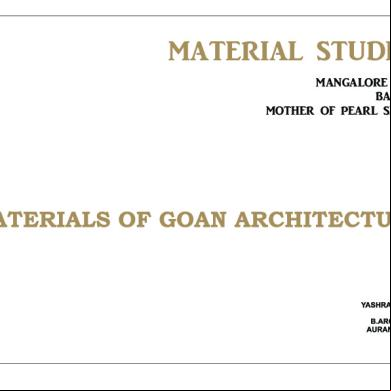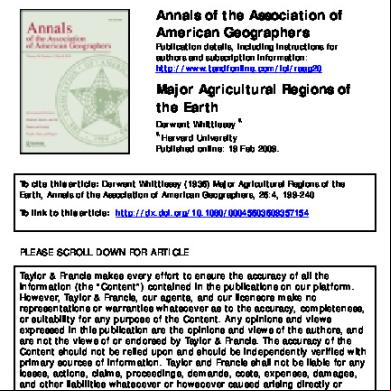Gothic Vaults 2w5q5n
This document was ed by and they confirmed that they have the permission to share it. If you are author or own the copyright of this book, please report to us by using this report form. Report 2z6p3t
Overview 5o1f4z
& View Gothic Vaults as PDF for free.
More details 6z3438
- Words: 1,491
- Pages: 13
The roofing of wide spaces presented a challenge to the medieval builder which resulted in some of the most impressive creations of the middle ages. The architecture of ancient Rome had provided precedents for different types of stone vaulting. Vaults continued to be constructed over small spaces, but in England in the early middle ages large spans had timber roofs , developing the practices known to have been established as early as the 7th century for the great timber halls of the Anglo-Saxons. Timber roofs achieved great sophistication in the 14th and 15th centuries, using a variety of techniques to cover wide spans.
Stone Vaulting • The introduction of stone vaulting below the timber roof revolutionised the appearance of major churches. • Stone vaults had the advantage of being fireproof, but also traditionally possessed symbolic significance as a way of marking the site of an especially sacred space, such as tombs or relic chambers in crypts. • From the 11th century onwards, as major churches were rebuilt on an increasingly ambitious scale, they sought to recapture the grandeur of the ancient Roman basilica, and the principle of the vaulted sacred space was extended to the whole building. • The invention of the rib-vault, combined with the pointed arch, made it possible for the vault to be carried on walls pierced by large openings, as the ribs directed the thrust to the corners of each bay and flying buttresses helped to stabilise the weight of the heavy masses of masonry. From the 13th century onwards Gothic stone vaults were elaborated to produce complex patterns by the addition of extra ribs and elaborately carved and painted bosses at their intersections.
Groin Vaults VAULTS are formed from two . intersecting barrel vaults (the groins are the edges of the intersections). They are built of heavy rubble masonry and so need adequate . They were used in the large crypts introduced by the Normans below their new abbeys and cathedrals, where the space was divided into a series of small bays by numerous columns, as at Canterbury, Worcester and Gloucester
Canterbury Cathedral, Kent., Crypt
Rib Vaults In the RIB-VAULT the main thrust is carried by masonry ribs to the corners of each. The ribs of cut stone form a framework, so that lighter material can be used to fill the cells in between. The adoption of the stronger and more adaptable pointed arch, a concept borrowed from the eastern Mediterranean, made it possible to vault awkwardly shaped spaces while keeping the vault to a more or less even height.
From the later 13th century most major churches aspired to stone vaults, although such costly additions were not always carried out, and sometimes a timber vault simulating stone was provided instead.
Tierceron & Lierne Vaults The TIERCERON VAULT has additional ribs (tiercerons, from tierce, third) springing from wall shaft or pier at the corner of each bay to the ridge ribs along the apexes of the vault.
.
The type was developed from the 13th to early 14th centuries; examples of increasing richness can be seen in the cathedrals of Lincoln, Ely, Exeter and Wells Cathedral Chapter House. Although the tiercerons are not structurally essential, they are given the same thickness as the principal diagonal ribs; as a result the visual division of thevault into quadrangular bays disappears.
Tierceron vault
Gloucester Cathedral, Choir Wells Cathedral. Chapter House
• LIERNE VAULTS have short linking ribs (liernes , from French lien to bind) in the crown of the vault between the main ribs. • They provide the opportunity for additional carved bosses at the junctions. • At its most elaborate, such a vault resembles a net stretched below the roof, creating •a pattern which During the period of the Decorated Style there was an ignores the traditionincrease of and elaboration of intermediate ribs individual bay divisions. (tiercerons), ridge ribs, and a new set of ribs known as Lierne ribs, from the French lien — to bind or hold. The name "lierne" is applied to any rib, except a ridge rib, not springing from an abacus. • In the early plain-ribbed vaulting each rib marked a groin, i.e., a change in the direction of the vaulting surface, but lierne ribs were merely ribs lying in a vaulting surface, their form being determined independently of such surface, which, however, regulated their curvature. • These liernes, by their number and disposition, often give an elaborate or intricate appearance to a really
Fan Vaults The FAN VAULT is a sophisticated form of barrel vault built of cut stone, consisting of inverted conoids decorated with a fan of purely decorative surface ribs, often with pendant bosses. Gloucester Cathedral, Cloister Fan vaults appear at first over small spaces, the earliest known structural examples are those of the 14th century in the cloister of Gloucester Cathedral.
Peterborough Cathedral, Retrochoir On a large scale the fan vault remained exceptional, associated with especially prestigious buildings in the Perpendicular style of the end
othic Windows and Tracery The commonly used names, Early English, Decorated and Perpendicular were first used by Thomas Rickman, in his Attempt to Discriminate the Style of Architecture in England, first published 1812-15. • The grouped lancet windows of the Early English period of Gothic gave way by the mid 13th century to the tracery window. • Gothic tracery is based on the geometry of circles, as is clearly visible in the earliest examples where the heads of the windows are filled by one or more roundels. • The lower part of the window opening was divided up into several 'lights' by vertical mullions of coursed masonry, the roundels are composed of curved 'bars' of masonry, often with petal-like cusping around the inside of the circle. • This invention of 'bar tracery' began in in the earlier 13th century, and was rapidly adopted in England from the 1240s, the rebuilt choir of Westminster Abbey providing a prestigious example of the Geometric style. • From the late 13th century and through the 14th century the geometry became more complicated and subtle; the complex patterns of the Decorated style were created by combining parts of circles to form exuberant flowing or net-like designs. •
Early English Tracery The adoption of the pointed arch in the later encouraged a new and more flexible approach to window design. Lancet windows could be used separately if the space was tight, or grouped together in a single composition, with windows either of identical height, or graduated to fill a gable wall. The pointed arch was also used to transform the Romanesque tradition of decorative arcading .
Lancet Slender single-light, pointed-arched window. Hence lancet style, the first phase of English Gothic architecture (c. 1180-1250; also called Early English), from its use of such windows.
Geometric Tracery 'Geometric is a term used for the early type of bar tracery, a French invention adopted for the East end of Westminster Abbey, begun in 1245. The chapel windows, seen to the left, are divided into two lights separated by a slim central mullion with a pointed arch above filled by a foiled circle.
The principal of the window with several lights surmounted by a circle could be elaborated for larger areas, by increasing the number of lights and circles. Large windows of the Geometric period had an even number of lights arranged in pairs, each pair with its own circle. See how a complex Geometric window is composed. Westminster Abbey, London., E en The largest example is the eight-light east window of Lincoln Cathedral Angel Choir where the window is made up of two times two pairs, or 4 + 4 lights, with a total of 13
Flowing tracery Bar tracery with uninterrupted flowing curves, typical of the 14th century; also called curvilinear tracery. Foil (lit. leaf): Lobe formed by the cusping of a circular or other shape in tracery. Trefoil (three), quatrefoil (four), cinquefoil (five), sexfoil (six) and multifoil express the number of Geometric lobes in a shape. English Gothic architecture c. 1240-1290. During this period the French invention of bar tracery allowed for larger windows subdivided by stone mullions and tracery, in place of the single lancets of the Early English style. Geometrical tracery is the earliest kind of this bar tracery, i.e. with patterns formed by intersecting moulded ribwork continuing Flamboyant The latest phase of French Gothic architecture, with flowing tracery.
Intersecting tracery A type of bar tracery used c. 1300, formed by interlocking mullions each branching out in two curved bars of the same radius but different centres.
Kentish cusp In tracery in the Gothic style, a cusp or curved projection which has a v-shaped opening set within the apex. Also called a split cusp.
Mouchette A curved dagger-shaped motif in tracery, popular especially in the 14th century.
Multifoil With multiple lobes (foils) formed by the cusping of a circular or other shape in tracery.
tracery Bar tracery with even upright divisions made by a horizontal transom or transoms.
Stone Vaulting • The introduction of stone vaulting below the timber roof revolutionised the appearance of major churches. • Stone vaults had the advantage of being fireproof, but also traditionally possessed symbolic significance as a way of marking the site of an especially sacred space, such as tombs or relic chambers in crypts. • From the 11th century onwards, as major churches were rebuilt on an increasingly ambitious scale, they sought to recapture the grandeur of the ancient Roman basilica, and the principle of the vaulted sacred space was extended to the whole building. • The invention of the rib-vault, combined with the pointed arch, made it possible for the vault to be carried on walls pierced by large openings, as the ribs directed the thrust to the corners of each bay and flying buttresses helped to stabilise the weight of the heavy masses of masonry. From the 13th century onwards Gothic stone vaults were elaborated to produce complex patterns by the addition of extra ribs and elaborately carved and painted bosses at their intersections.
Groin Vaults VAULTS are formed from two . intersecting barrel vaults (the groins are the edges of the intersections). They are built of heavy rubble masonry and so need adequate . They were used in the large crypts introduced by the Normans below their new abbeys and cathedrals, where the space was divided into a series of small bays by numerous columns, as at Canterbury, Worcester and Gloucester
Canterbury Cathedral, Kent., Crypt
Rib Vaults In the RIB-VAULT the main thrust is carried by masonry ribs to the corners of each. The ribs of cut stone form a framework, so that lighter material can be used to fill the cells in between. The adoption of the stronger and more adaptable pointed arch, a concept borrowed from the eastern Mediterranean, made it possible to vault awkwardly shaped spaces while keeping the vault to a more or less even height.
From the later 13th century most major churches aspired to stone vaults, although such costly additions were not always carried out, and sometimes a timber vault simulating stone was provided instead.
Tierceron & Lierne Vaults The TIERCERON VAULT has additional ribs (tiercerons, from tierce, third) springing from wall shaft or pier at the corner of each bay to the ridge ribs along the apexes of the vault.
.
The type was developed from the 13th to early 14th centuries; examples of increasing richness can be seen in the cathedrals of Lincoln, Ely, Exeter and Wells Cathedral Chapter House. Although the tiercerons are not structurally essential, they are given the same thickness as the principal diagonal ribs; as a result the visual division of thevault into quadrangular bays disappears.
Tierceron vault
Gloucester Cathedral, Choir Wells Cathedral. Chapter House
• LIERNE VAULTS have short linking ribs (liernes , from French lien to bind) in the crown of the vault between the main ribs. • They provide the opportunity for additional carved bosses at the junctions. • At its most elaborate, such a vault resembles a net stretched below the roof, creating •a pattern which During the period of the Decorated Style there was an ignores the traditionincrease of and elaboration of intermediate ribs individual bay divisions. (tiercerons), ridge ribs, and a new set of ribs known as Lierne ribs, from the French lien — to bind or hold. The name "lierne" is applied to any rib, except a ridge rib, not springing from an abacus. • In the early plain-ribbed vaulting each rib marked a groin, i.e., a change in the direction of the vaulting surface, but lierne ribs were merely ribs lying in a vaulting surface, their form being determined independently of such surface, which, however, regulated their curvature. • These liernes, by their number and disposition, often give an elaborate or intricate appearance to a really
Fan Vaults The FAN VAULT is a sophisticated form of barrel vault built of cut stone, consisting of inverted conoids decorated with a fan of purely decorative surface ribs, often with pendant bosses. Gloucester Cathedral, Cloister Fan vaults appear at first over small spaces, the earliest known structural examples are those of the 14th century in the cloister of Gloucester Cathedral.
Peterborough Cathedral, Retrochoir On a large scale the fan vault remained exceptional, associated with especially prestigious buildings in the Perpendicular style of the end
othic Windows and Tracery The commonly used names, Early English, Decorated and Perpendicular were first used by Thomas Rickman, in his Attempt to Discriminate the Style of Architecture in England, first published 1812-15. • The grouped lancet windows of the Early English period of Gothic gave way by the mid 13th century to the tracery window. • Gothic tracery is based on the geometry of circles, as is clearly visible in the earliest examples where the heads of the windows are filled by one or more roundels. • The lower part of the window opening was divided up into several 'lights' by vertical mullions of coursed masonry, the roundels are composed of curved 'bars' of masonry, often with petal-like cusping around the inside of the circle. • This invention of 'bar tracery' began in in the earlier 13th century, and was rapidly adopted in England from the 1240s, the rebuilt choir of Westminster Abbey providing a prestigious example of the Geometric style. • From the late 13th century and through the 14th century the geometry became more complicated and subtle; the complex patterns of the Decorated style were created by combining parts of circles to form exuberant flowing or net-like designs. •
Early English Tracery The adoption of the pointed arch in the later encouraged a new and more flexible approach to window design. Lancet windows could be used separately if the space was tight, or grouped together in a single composition, with windows either of identical height, or graduated to fill a gable wall. The pointed arch was also used to transform the Romanesque tradition of decorative arcading .
Lancet Slender single-light, pointed-arched window. Hence lancet style, the first phase of English Gothic architecture (c. 1180-1250; also called Early English), from its use of such windows.
Geometric Tracery 'Geometric is a term used for the early type of bar tracery, a French invention adopted for the East end of Westminster Abbey, begun in 1245. The chapel windows, seen to the left, are divided into two lights separated by a slim central mullion with a pointed arch above filled by a foiled circle.
The principal of the window with several lights surmounted by a circle could be elaborated for larger areas, by increasing the number of lights and circles. Large windows of the Geometric period had an even number of lights arranged in pairs, each pair with its own circle. See how a complex Geometric window is composed. Westminster Abbey, London., E en The largest example is the eight-light east window of Lincoln Cathedral Angel Choir where the window is made up of two times two pairs, or 4 + 4 lights, with a total of 13
Flowing tracery Bar tracery with uninterrupted flowing curves, typical of the 14th century; also called curvilinear tracery. Foil (lit. leaf): Lobe formed by the cusping of a circular or other shape in tracery. Trefoil (three), quatrefoil (four), cinquefoil (five), sexfoil (six) and multifoil express the number of Geometric lobes in a shape. English Gothic architecture c. 1240-1290. During this period the French invention of bar tracery allowed for larger windows subdivided by stone mullions and tracery, in place of the single lancets of the Early English style. Geometrical tracery is the earliest kind of this bar tracery, i.e. with patterns formed by intersecting moulded ribwork continuing Flamboyant The latest phase of French Gothic architecture, with flowing tracery.
Intersecting tracery A type of bar tracery used c. 1300, formed by interlocking mullions each branching out in two curved bars of the same radius but different centres.
Kentish cusp In tracery in the Gothic style, a cusp or curved projection which has a v-shaped opening set within the apex. Also called a split cusp.
Mouchette A curved dagger-shaped motif in tracery, popular especially in the 14th century.
Multifoil With multiple lobes (foils) formed by the cusping of a circular or other shape in tracery.
tracery Bar tracery with even upright divisions made by a horizontal transom or transoms.










